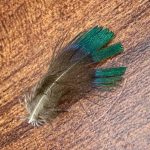Holy Grail Pheasant Tail Nymph (variant)


Bead Head Nymph, Nymph
Tied By Joe Glessner
Hook: Any Scud, Size #10-20 (Wholesale Fly Conpany M11 Size #14 as tied)
Thread: 8/0 Semperfli, Brown
Materials- bead: 2.8mm Tungsten, Gold rib: Fine Gold Wire (0.2mm Sybai Colour Wire, Bright Gold as tied) abdomen: Ringneck Pheasant Tail, 6-8 fibers wing case: Ringneck Pheasant Tail, 6-8 fibers thorax: Ice Dub, Peacock hackle: Cock Ringneck Pheasant Head Feather
Notes:
Davie McPhail ties these with Hungarian Partridge as the hackle, but I prefer the symmetry of using a feather from the head of the Ringneck Pheasant.
Tying Instructions
- Mount the bead on the hook and secure the hook in the vise. Attach thread with a jam wrap at the midpoint of the hook shank.
- Mount the wire for the rib on the bottom of the hook shank and wrap back well into the bend of the hook using touching turns, taking care to keep the wire on the bottom of the hook shank and ending by taking one wrap forward.
- Even the tips on the pheasant tail for the abdomen before removing them from the rachis, trim the tips flush and mount them to the far side of the hook with the butt ends to the rear of the hook. Wrap forward using touching turns to the 2/3 point of the hook shank.
- Keeping the fibers as flat and untwisted as possible, counter wrap them forward using touching turns to the 2/3 point and tie them off before trimming away the excess.
- Wrap the wire forward in open and evenly spaced spirals to the 2/3 point before tying it off and helicoptering the excess free.
- Select 6-8 pheasant tail barbs for the wing case, evening the tips before removing them from the rachis. Trim the tips flush and carefully mount them to the top of the hook shank with the butt ends toward the hook bend. Wrap over them neatly, just back over the abdomen.
- Form a tightly dubbed noodle of Ice Dub about two inches long. Leaving enough space for the bead to be pushed back enough to mount and wrap the hackle, form a tight ball of dubbing for the thorax directly in front of the abdomen. The ball should be at least the size of, or slightly thicker than the diameter of the bead. End with your thread where it will be behind the bead once the bead is pushed back.
- Add a small amount of glue or head cement to the thread and whip finish before snipping the thread free.
- Push the bead back into the thorax and reattach the thread directly behind the eye of the hook, taking wraps to trap the bead back far enough to mount the hackle.
- Place a very small bit of head cement directly on top of the bead, and carefully pull the wing case forward over the bead and take one or two wraps to secure it. Take one wrap directly in front of the fibers and two more behind. Keeping tension on the thread, carefully break the pheasant tail fiber excess free, one or two fibers at a time. This will result in a much neater head than if you trim them.
- Select an iridescent blue/green feather from the head of the pheasant skin. Strip away any fluff, and using hackle pliers to hold the very tip of the feather, sweep the fibers down creating a tie in point by trimming the fibers held in the hackle pliers into a neat reverse triangle. Due to the size of this feather, you will only get one, maybe two wraps around the hook shank.
- Mount the feather to the bead side of the hook shank, as close to the bead as you can and carefully wrap the feather as you would any soft hackle, sweeping the fibers to the rear as you wrap to avoid trapping any.
- Tie off the hackle, and trim the excess away.
- Use a half hitch tool or the tip of a pen to push the hackle to the rear.
- Pinch the fibers to keep them in place, and take a wrap or two over them to keep them that way. The bead will act as a prop.
- Form a very small thread head to cover any exposed butts and whip finish before snipping the thread free.
